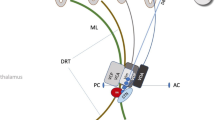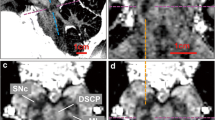Abstract
Background
Deep brain stimulation (DBS) of the medial forebrain bundle (MFB) was reported to reduce symptoms in psychiatric disorders. The aim of our study was to find standardised parameters for diffusion tensor imaging (DTI) based fibre tracking to reliably visualise the MFB.
Methods
Twenty-two cerebral hemispheres in 11 patients were investigated. Three different regions of interest (ROIs) were defined as seed regions for fibre tracking: the ipsilateral and contralateral superior cerebellar peduncle (SCP) and the nucleus raphe dorsalis (NRD). From each seed region the fibres were followed separately through the ventral tegmental area (VTA = second ROI) and their further courses and volumina were documented and compared. Minimal fibre length was set at 30 mm and the FA threshold at 0.12.
Results
The fibre tracts starting in seed regions in the ipsilateral SCP and the NRD follow a similar course along the lateral wall of the third ventricle (hypothalamus) and the anterior limb of the internal capsule (ALIC) to inferior fronto-medial brain areas. These fibres are in accordance with the course of the MFB as described in various anatomical atlases. Consistently, a branch leaves the main fibre tract laterally to take a course through the capsula externa to the temporo-parietal cortex. Fibre tracts starting from the contralateral SCP follow a more superior and lateral course, including the dentato-rubro-thalamic and the pyramidal tract.
Conclusions
Deterministic fibre tracking with standardised ROIs provides constant and reproducible delineations of the medial forebrain bundle. Its visualisation might help to adjust targeting in DBS for psychiatric disorders.



Similar content being viewed by others
References
Abelson JL, Curtis GC, Sagher O, Albucher RC, Harrigan M, Taylor SF, Martis B, Giordani B (2005) Deep brain stimulation for refractory obsessive-compulsive disorder. Biol Psychiatry 57(5):510–516
Anne M (2007) Stereotactic atlas of the human thalamus and basal ganglia. Informa Healthcare, New York
Anthofer J, Steib K, Fellner C, Lange M, Brawanski A, Schlaier J (2014) The variability of atlas-based targets in relation to surrounding major fibre tracts in thalamic deep brain stimulation. Acta Neurochir (Wien) 156(8):1497–1504, discussion 1504
Aouizerate B, Martin-Guehl C, Cuny E, Guehl D, Amieva H, Benazzouz A, Fabrigoule C, Allard M, Rougier A, Burbaud P, Tignol J, Bioulac B (2005) Stimulation cérébrale profonde du striatum ventral dans le traitement du trouble obsessionnel-compulsif avec dépression majeure (Deep brain stimulation of the ventral striatum in the treatment of obsessive-compulsive disorder and major depression). Med Sci (Paris) 21(10):811–813
Bewernick BH, Hurlemann R, Matusch A, Kayser S, Grubert C, Hadrysiewicz B, Axmacher N, Lemke M, Cooper-Mahkorn D, Cohen MX, Brockmann H, Lenartz D, Sturm V, Schlaepfer TE (2010) Nucleus accumbens deep brain stimulation decreases ratings of depression and anxiety in treatment-resistant depression. Biol Psychiatry 67(2):110–116
Bewernick BH, Kayser S, Sturm V, Schlaepfer TE (2012) Long-term effects of nucleus accumbens deep brain stimulation in treatment-resistant depression: evidence for sustained efficacy. Neuropsychopharmacology 37(9):1975–1985
Bronte-Stewart H, Taira T, Valldeoriola F, Merello M, Marks WJ, Albanese A, Bressman S, Moro E (2011) Inclusion and exclusion criteria for DBS in dystonia. Mov Disord 26(Suppl 1):S5–S16
Coenen VA, Allert N, Paus S, Kronenbürger M, Urbach H, Mädler B (2014) Modulation of the cerebello-thalamo-cortical network in thalamic deep brain stimulation for tremor. Neurosurgery. doi:10.1227/NEU.0000000000000540
Coenen VA, Honey CR, Hurwitz T, Rahman AA, McMaster J, Bürgel U, Mädler B (2009) Medial forebrain bundle stimulation as a pathophysiological mechanism for hypomania in subthalamic nucleus deep brain stimulation for Parkinson’s disease. Neurosurgery 64(6):1106–1114, discussion 1114–5
Coenen VA, Mädler B, Schiffbauer H, Urbach H, Allert N (2011) Individual fiber anatomy of the subthalamic region revealed with diffusion tensor imaging: a concept to identify the deep brain stimulation target for tremor suppression. Neurosurgery 68(4):1069–1075, discussion 1075–6
Coenen VA, Panksepp J, Hurwitz TA, Urbach H, Mädler B (2012) Human medial forebrain bundle (MFB) and anterior thalamic radiation (ATR): imaging of two major subcortical pathways and the dynamic balance of opposite affects in understanding depression. J Neuropsychiatry Clin Neurosci 24(2):223–236
Coenen VA, Schlaepfer TE, Maedler B, Panksepp J (2011) Cross-species affective functions of the medial forebrain bundle-implications for the treatment of affective pain and depression in humans. Neurosci Biobehav Rev 35(9):1971–1981
Fisher R, Salanova V, Witt T, Worth R, Henry T, Gross R, Oommen K, Osorio I, Nazzaro J, Labar D, Kaplitt M, Sperling M, Sandok E, Neal J, Handforth A, Stern J, DeSalles A, Chung S, Shetter A, Bergen D, Bakay R, Henderson J, French J, Baltuch G, Rosenfeld W, Youkilis A, Marks W, Garcia P, Barbaro N, Fountain N, Bazil C, Goodman R, McKhann G, Babu Krishnamurthy K, Papavassiliou S, Epstein C, Pollard J, Tonder L, Grebin J, Coffey R, Graves N (2010) Electrical stimulation of the anterior nucleus of thalamus for treatment of refractory epilepsy. Epilepsia 51(5):899–908
Geisler S, Zahm DS (2006) On the retention of neurotensin in the ventral tegmental area (VTA) despite destruction of the main neurotensinergic afferents of the VTA—implications for the organization of forebrain projections to the VTA. Brain Res 1087(1):87–104
Greenberg BD, Gabriels LA, Malone DA, Rezai AR, Friehs GM, Okun MS, Shapira NA, Foote KD, Cosyns PR, Kubu CS, Malloy PF, Salloway SP, Giftakis JE, Rise MT, Machado AG, Baker KB, Stypulkowski PH, Goodman WK, Rasmussen SA, Nuttin BJ (2010) Deep brain stimulation of the ventral internal capsule/ventral striatum for obsessive-compulsive disorder: worldwide experience. Mol Psychiatry 15(1):64–79
Greenberg BD, Malone DA, Friehs GM, Rezai AR, Kubu CS, Malloy PF, Salloway SP, Okun MS, Goodman WK, Rasmussen SA (2006) Three-year outcomes in deep brain stimulation for highly resistant obsessive-compulsive disorder. Neuropsychopharmacology 31(11):2384–2393
Hilker R, Benecke R, Deuschl G, Fogel W, Kupsch A, Schrader C, Sixel-Döring F, Timmermann L, Volkmann J, Lange M (2009) Tiefe Hirnstimulation bei idiopathischem Parkinson-Syndrom. Empfehlungen der Deutschen Arbeitsgemeinschaft Tiefe Hirnstimulation (Deep brain stimulation for Parkinson’s disease. Consensus recommendations of the German Deep Brain Stimulation Association). Nervenarzt 80(6):646–655
Klein E, Moeller K, Glauche V, Weiller C, Willmes K, Draganski B (2013) Processing pathways in mental arithmetic—evidence from probabilistic fiber tracking. PLoS One. doi:10.1371/journal.pone.0055455
Kohl S, Schönherr DM, Luigjes J, Denys D, Mueller UJ, Lenartz D, Visser-Vandewalle V, Kuhn J (2014) Deep brain stimulation for treatment-refractory obsessive compulsive disorder: a systematic review. BMC Psychiatr 14:214
Kuhn J, Lenartz D, Huff W, Lee S, Koulousakis A, Klosterkoetter J, Sturm V (2007) Remission of alcohol dependency following deep brain stimulation of the nucleus accumbens: valuable therapeutic implications? J Neurol Neurosurg Psychiatr 78(10):1152–1153
Kuhn J, Lenartz D, Mai JK, Huff W, Lee S, Koulousakis A, Klosterkoetter J, Sturm V (2007) Deep brain stimulation of the nucleus accumbens and the internal capsule in therapeutically refractory Tourette-syndrome. J Neurol 254(7):963–965
Lapidus KAB, Stern ER, Berlin HA, Goodman WK (2014) Neuromodulation for obsessive-compulsive disorder. Neurotherapeutics 11(3):485–495
Lipsman N, Giacobbe P, Lozano AM (2013) Deep brain stimulation in obsessive-compulsive disorder: neurocircuitry and clinical experience. Handb Clin Neurol 116:245–250
Lozano AM, Mayberg HS, Giacobbe P, Hamani C, Craddock RC, Kennedy SH (2008) Subcallosal cingulate gyrus deep brain stimulation for treatment-resistant depression. Biol Psychiatry 64(6):461–467
Mai JK (1997) Atlas of the human brain. Academic, San Diego
Mallet L, Mesnage V, Houeto J, Pelissolo A, Yelnik J, Behar C, Gargiulo M, Welter M, Bonnet A, Pillon B, Cornu P, Dormont D, Pidoux B, Allilaire J, Agid Y (2002) Compulsions, Parkinson’s disease, and stimulation. Lancet 360(9342):1302–1304
Malone DA, Dougherty DD, Rezai AR, Carpenter LL, Friehs GM, Eskandar EN, Rauch SL, Rasmussen SA, Machado AG, Kubu CS, Tyrka AR, Price LH, Stypulkowski PH, Giftakis JE, Rise MT, Malloy PF, Salloway SP, Greenberg BD (2009) Deep brain stimulation of the ventral capsule/ventral striatum for treatment-resistant depression. Biol Psychiatry 65(4):267–275
Morishita T, Fayad SM, Goodman WK, Foote KD, Chen D, Peace DA, Rhoton AL, Okun MS (2014) Surgical neuroanatomy and programming in deep brain stimulation for obsessive compulsive disorder. Neuromodulation 17(4):312–319
Morishita T, Fayad SM, Higuchi M, Nestor KA, Foote KD (2014) Deep brain stimulation for treatment-resistant depression: systematic review of clinical outcomes. Neurotherapeutics 11(3):475–484
Müller UJ, Voges J, Steiner J, Galazky I, Heinze H, Möller M, Pisapia J, Halpern C, Caplan A, Bogerts B, Kuhn J (2013) Deep brain stimulation of the nucleus accumbens for the treatment of addiction. Ann N Y Acad Sci 1282:119–128
Nuttin B, Gielen F, van Kuyck K, Wu H, Luyten L, Welkenhuysen M, Brionne TC, Gabriëls L (2013) Targeting bed nucleus of the stria terminalis for severe obsessive-compulsive disorder: more unexpected lead placement in obsessive-compulsive disorder than in surgery for movement disorders. World Neurosurg 80(3–4):S30.e11-S30.e16
Oades RD, Halliday GM (1987) Ventral tegmental (A10) system: neurobiology. 1. Anatomy and connectivity. Brain Res 434(2):117–165
Schlaepfer TE, Bewernick BH (2013) Deep brain stimulation for major depression. Handb Clin Neurol 116:235–243
Schlaepfer TE, Bewernick BH, Kayser S, Hurlemann R, Coenen VA (2014) Deep brain stimulation of the human reward system for major depression—rationale, outcomes and outlook. Neuropsychopharmacology 39(6):1303–1314
Schlaepfer TE, Bewernick BH, Kayser S, Mädler B, Coenen VA (2013) Rapid effects of deep brain stimulation for treatment-resistant major depression. Biol Psychiatry 73(12):1204–1212
Schlaepfer TE, George MS, Mayberg H (2010) WFSBP guidelines on brain stimulation treatments in psychiatry. World J Biol Psychiatry 11(1):2–18
Schoene-Bake J, Parpaley Y, Weber B, Panksepp J, Hurwitz TA, Coenen VA (2010) Tractographic analysis of historical lesion surgery for depression. Neuropsychopharmacology 35(13):2553–2563
Sixel-Döring F, Benecke R, Fogel W, Hilker R, Kupsch A, Lange M, Schrader C, Timmermann L, Volkmann J, Deuschl G (2009) Tiefe Hirnstimulation bei essenziellem Tremor. Empfehlungen der Deutschen Arbeitsgemeinschaft Tiefe Hirnstimulation (Deep brain stimulation for essential tremor. Consensus recommendations of the German Deep Brain Stimulation Association). Nervenarzt 80(6):662–665
Sturm V, Lenartz D, Koulousakis A, Treuer H, Herholz K, Klein JC, Klosterkötter J (2003) The nucleus accumbens: a target for deep brain stimulation in obsessive-compulsive- and anxiety-disorders. J Chem Neuroanat 26(4):293–299
van Kuyck K, Gabriëls L, Cosyns P, Arckens L, Sturm V, Rasmussen S, Nuttin B (2007) Behavioural and physiological effects of electrical stimulation in the nucleus accumbens: a review. Acta Neurochir Suppl 97(Pt 2):375–391
van Nieuwenhuys RVJHC (2008) The human central nervous system. Springer, Berlin Heidelberg New York
Wakana S, Jiang H, Nagae-Poetscher LM, van Zijl PCM, Mori S (2004) Fiber tract-based atlas of human white matter anatomy. Radiology 230(1):77–87
Zahm DS (2006) The evolving theory of basal forebrain functional-anatomical ‘macrosystems’. Neurosci Biobehav Rev 30(2):148–172
Conflicts of interest
J. Anthofer has received travel grants and training fees for educational courses in functional neurosurgery from Medtronic.
K. Steib has received travel grants and training fees for educational courses in functional neurosurgery from Medtronic and St. Jude Medical.
J. Schlaier has received teaching honoraria from Medtronic, Inc. and research support from the following companies: St. Jude Medical, Antisense Pharma and Medtronic. He has given several talks which were partly sponsored by Medtronic, St. Jude Medical or BrainLab. He serves as consultant to Medtronic, Inc. and receives compensation for these services.
C. Fellner reports no conflict of interest.
E. Rothenfusser received fees for serving as a speaker in courses sponsored by Ipsen and Merz.
A. Brawanski reports no conflict of interest.
M. Lange has received fees for serving as a speaker, a consultant and an advisory board member for Medtronic and UCB, and has received research funding from UCB and St. Jude Medical.
Author information
Authors and Affiliations
Corresponding author
Rights and permissions
About this article
Cite this article
Anthofer, J.M., Steib, K., Fellner, C. et al. DTI-based deterministic fibre tracking of the medial forebrain bundle. Acta Neurochir 157, 469–477 (2015). https://doi.org/10.1007/s00701-014-2335-y
Received:
Accepted:
Published:
Issue Date:
DOI: https://doi.org/10.1007/s00701-014-2335-y




